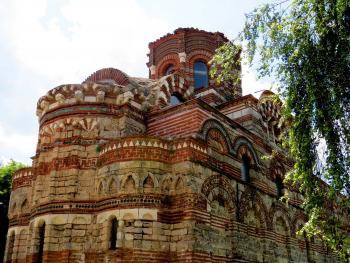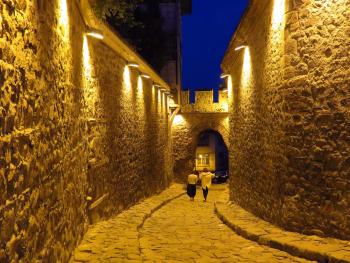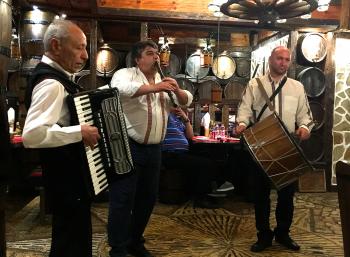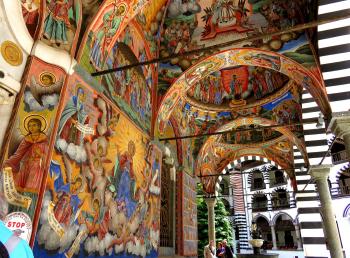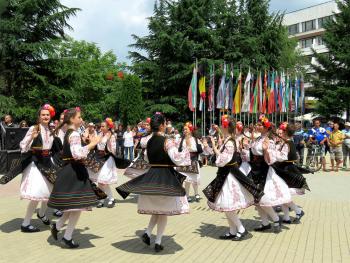Discovering Bulgaria’s monastic history on a self-drive tour
This article appears on page 6 of the May 2017 issue.
This past June, my husband, Fred, and I rented a car and drove through Bulgaria and the Transylvania region of Romania. As I planned the trip, I discovered the monastic history of both countries and their numerous UNESCO World Heritage Sites.
Beginning in Bulgaria
The almost 500-year influence of the Ottoman Empire coupled with exposure to European culture makes Bulgaria a fascinating travel destination. The countryside has picturesque mountains and valleys, there are pristine medieval towns that haven’t been overrun with tourists, the Black Sea has lovely, sandy beaches, there are impressive monasteries throughout the country, and wine regions are worth the trip.
We started our trip in Sofia, the country’s capital. We had prearranged a rental car, which we planned to pick up at the airport, but our incoming flight was delayed, so we opted to take the car service offered by our hotel (€36, or $39) and have the rental car delivered to us at the Grand Hotel Sofia (grandhotelsofia.bg) the following day. The rental company YES Rent-a-car (Sofia, Bulgaria; yesrentacar.bg) could not have been more accommodating.
Grand Hotel Sofia, a 4-star hotel on Gurko Street, in the center of the city, was conveniently located adjacent to City Garden and the National Theatre and within walking distance of every site we wanted to see in the city. The hotel provided free parking in their underground garage, which was an added benefit.
A breakfast buffet was available at the hotel for an additional charge, but, not wanting a big breakfast, we decided to explore other options. Much to our surprise, finding a restaurant for breakfast was not easy.
There was a McDonald’s just a few blocks away, but it didn’t open until 10 a.m. On Gurko Street, where our hotel was located, we eventually found Ciccione Panini Bar & Bakery, and for 13 levs ($7) we had a breakfast of a salad, panini and coffee for two.
At 11 a.m. we met a group at the Palace of Justice, a few blocks from our hotel, for a free 2-hour walking tour of the city led by guide Kristina. We covered many of the city’s churches and the Roman ruins and ended the tour at the St. Sofia Church and Alexander Nevsky Cathedral. The Cathedral is one of the landmarks of Sofia, but the interior was very dark, making it difficult to appreciate the icons and paintings on the walls.
For dinner, we went to Tavern Izbata, a restaurant recommended by Kristina. We had a great meal of roasted eggplant with cheese, a salad of tomatoes, cheese and basil and a casserole of meat and mushrooms accompanied by No Man’s Land wine, a locally produced sauvignon blanc, plus a beer, also local. The bill was about $20 for the two of us.
The next morning we walked to ul. Pirotska, a pedestrian street a few blocks from our hotel, for breakfast at a bakery next door to McDonald’s. We ordered cappuccinos, and I had a condola (a curved bread with egg and cheese) and Fred got a meat-filled roll. Both were delicious.
Next we headed to the Sofia Synagogue, stopping at Halite (an indoor market hall) along the way. Built in 1909 and renovated in the 1990s, it now houses cheese and wine shops and cafés. We bought three different cheeses, a loaf of bread and a bottle of wine for a total of about $12.
The Sofia Synagogue was just next to the market. Built in the early 1900s, it is one of the largest Sephardic synagogues in Europe. The interior was beautiful, with Bulgarian-style decorations. Entrance to the synagogue cost 2 lev.
Walking back to ul. Pirotska, we passed the TZUM building, a showpiece department store left over from Soviet times. Though it has been remodeled and contains a few upscale stores, most of it was not being used.
Sacred sites
On our itinerary the next day was Boyana Church, located 9 kilometers outside the city. At noon, as we were driving out of Sofia, there was the sounding of a siren that could be heard throughout the city. Everyone stopped what they were doing.
People stopped driving, got out of their cars and stood in the middle of the street. Children on the schoolyard stood at attention.
There were a few minutes of silence, then everyone returned to what they had been doing before the siren sounded. We had no idea what was happening.
Later we learned that it is an annual occurrence (June 2) to honor the revolutionary Hristo Botev and all those who lost their lives fighting for liberation from Ottoman rule in the late 19th century.
We got to Boyana Church just as a tour bus was leaving, so we had the site all to ourselves. One of Bulgaria’s greatest treasures, the church has been a UNESCO World Heritage Site since 1979.
The original church was built in the 10th century and a second section was added in the 13th century. It was in continuous use until 1954.
The faces on the frescoes, which, in the old section, are two to three layers deep, were amazingly realistic. Visitors are usually allowed only 10 minutes in the small chapel of the oldest section, but we had longer since the monastery was empty. A guide gave us an overview in English. (Admission to the church cost 10 lev.)
Next we visited Dragalevtsi Monastery, situated on the side of Vitosha Mountain, its yard full of colorful native flowers. We continued to the top of the mountain (2,200 meters), where the weather dramatically changed. It was much cooler and very windy, and there were patches of snow on the ground.
On the way back down, we had great views of the valley and Sofia below.
For dinner, we went to a Bulgarian restaurant, Hadjidraganov’s Houses (ul. Hristo Belchev 18), just a few blocks from our hotel. Originally a rich merchant’s house, the restaurant had two floors; we ate on the lower level, which was once a wine cellar.
The restaurant’s walls were adorned with animal heads, and musicians playing folk music circulated between the two floors, contributing to the great atmosphere.
There were a lot of tourists but many locals as well. I had grilled salmon, which was delicious, and Fred had lamb (BGN58, total).
The next day we drove to Rila Monastery, an easy day trip from Sofia. In the center of the compound is the Church of the Nativity of the Virgin Mary, a magnificent structure of intricate carvings and brilliantly colored frescoes. There were many tour buses, but between the tours we enjoyed the beautiful, peaceful atmosphere.
A stop to smell the roses
During the month of June, the town of Kazanlâk and several neighboring towns hold an annual Rose Festival to celebrate the harvesting of the prized oil from the Rosa damascena, or damask rose. The crowning of the Rose Queen and a festival parade were taking place on the Sunday we were in Bulgaria, so we changed our itinerary to include the festival.
Kazanlâk is located in the Rose Valley, an area situated between two mountain ranges, the Balkan and Sredna Gora. The valley has an ideal climate for growing the oil-producing roses, which were brought to Bulgaria by Ottoman merchants and have been an important export since 1771.
Due to the popularity of the festival, it was impossible to get a hotel in Kazanlâk, so, from Sofia, we drove to the village of Bozhentsi. We got as far as Gabrovo easily, but from there, finding the village, which was spelled differently depending on which map we used, was a challenge. Thankfully, a local resident saw us parked in his driveway staring at the map on our iPad and came out to point us in the right direction.
Much to our surprise, when we got to the village, we discovered it was an architectural reserve and a UNESCO Cultural Site.
Our hotel, Bozhencite Relax, located a mile from the village, was rated as a 2-star hotel, but I feel it deserves a 3-star rating. The view from our balcony of the Balkan Mountains was serene and beautiful.
After our breakfast buffet the next morning, we retraced our route, driving south on Route 5 through Gabrovo and along the Shipka Pass, an impressive, curvy road through the mountains, to Kazanlâk. We arrived around 11:30 a.m. and followed directions from the police who were directing traffic to the Rose Festival.
We parked on the street not far from the park where they were holding a dedication ceremony in front of the new home of the Museum of the Rose. After the ceremony, we followed the crowd to the main plaza and squeezed in along the sidewalk to watch the parade.
The parade began at noon and went on till 1:30. Everyone marched in the parade — not only the groups participating in the folk dancing that would be held later that afternoon but every school band, dance company, martial arts school and motorcycle club.
After standing for that length of time, we needed a respite and stopped for a local Kamenitza beer at Bar Hollywood on the square. The square was lined with stalls selling rose oil, hand creams and rose-flavored Turkish delight.
The folk dancing started around 2 p.m., and we stood and watched the groups, representing various regions of Bulgaria and other Balkan countries, perform.
We drove back to our hotel through the Shipka Pass and stopped at the restaurant at the summit that was recommended by our guidebook for their famous buffalo yogurt. It was easy to spot the restaurant, as it had a sign with an upside-down buffalo in front of it. The yogurt was very thick and delicious.
Also at the top of this mountain is a monument to the thousands of Russian and Bulgarian soldiers who, after running out of ammunition following three days of fighting, used stones and logs to defend the pass from the Ottoman army. It is nearly 900 steps up to the monument.
Veliko Tarnovo
After another day of sightseeing nearby, we checked out of our hotel and backtracked through Gabrovo to Etar, an architectural and ethnographic complex of 50 craftsmen’s shops. There was a unique collection of crafts on display, with some demonstrations of how the works were created, all situated in a very pretty valley at the edge of town at the base of the road to Shipka Pass. Although it is a tourist attraction, it did not feel “touristy.”
Continuing north, we drove 50 kilometers to the city of Veliko Tarnovo. Our hotel, the 4-star Meridian Hotel Bolyarski (ul. Stefan Stambolov), was located in the old section of the city. Our unobstructed view overlooking the River Yantra and the houses stacked up the steep hills was spectacular!
Dinner was at Spelvelca, just a few feet from our hotel. It was very crowded, and service was slow, but we didn’t care. We started with focaccia with feta and white cheese, then I had a “lava dish” (cooked on a very hot grill) of stuffed squash, which was delicious, and Fred had chicken and mushrooms. With two very generous glasses of wine, the total bill was BGN22.
In the morning, we walked down the hill to the Information Center for a free walking tour. Our guide, Plami, was very knowledgeable about the history of the city and country.
We started the tour across the street at the statue that commemorates all the Bulgarian wars and kingdoms. Then we walked up the historic market street that was directly across from our hotel. This market street dates from the time of the Ottoman Empire occupation and now houses boutiques of artisans demonstrating various skills and selling souvenirs.
From Stefan Stambolov street, we had a view of the Tsarevets Fortress, the number-one attraction in the city. Our tour then continued to the cathedral and ended on Gurka Street. Steep stairs led us from Gurka Street back up to our hotel.
Later that afternoon, we crossed the bridge to the Tsarevets Fortress and paid the 6-lev entrance fee. To enter the grounds, we crossed a drawbridge, then walked through three large gates. The fortress, with 3-meter-thick and 12-meter-high walls, was a formidable sight.
The fortress’ Patriarchal Cathedral, at the summit of the hill, has been completely rebuilt, and murals were added to the interior. However, because the Russians were overseeing the project, traditional religious paintings were not allowed. Instead, rather grotesque pictures of the history of the city were painted, creating a unique interior but not one conducive to worship. (In fact, the church was never consecrated.)
The palace area was mostly in ruin, but the grounds of the fortress were large, and we spent more than two hours there.
Our gradual walk back uphill to our hotel took about 30 minutes.
Day trip
The following day we drove north to the village of Arbanasi, approximately 30 minutes by car from Veliko Tarnovo. We parked in the town square and walked to the Konstantsaliev House Museum, originally the home of a noble family.
The family lived on the second floor, and the first floor housed the cellar and animals. The house looked like a fortress, with the first level constructed of stone. The Ottoman influence was apparent throughout the house.
There are several churches in Arbanasi, but many were closed. The Church of the Nativity is one of the more spectacular churches, with frescoes from 1597. Every inch of the walls of the main church, chapel and entrance are covered from floor to ceiling with painted figures.
That evening we had tickets for the Sound and Light show at the fortress, which we watched from a viewing station next to the cathedral. It was a colorful show with multicolored lights and lasers flashing on and around the fortress to a background of music and bells. Tickets cost BGN25, which was expensive compared to other events we attended in Bulgaria.
Checking out of our hotel the next day, we headed back to Kazanlâk to visit the Thracian Tomb of Kazanlâk. This tomb of a Thracian king is situated in a park in the center of the city. The original tomb dates from the fourth century BC, but it is very fragile, so visitors tour a replica tomb instead. The frieze depicting a Thracian burial, located in the small, round burial chamber, is one of the most well-preserved wall paintings from this period. The tomb is a UNESCO World Heritage Site and worthy of a stop if you are in Kazanlâk.
Plovdiv
Our next destination, Plovdiv, is Bulgaria’s second-largest city after Sofia. The Old Town is located on a hill set apart from the rest of the city. With its gates and cobblestone streets (and restricted traffic), it exudes the feeling of a medieval city, though most of the houses date from the 1800s and are built in the National Revival style. Many houses have been turned into museums.
We stayed at the Boris Palace, a wonderful boutique hotel on Saborna Street, the main street in Old Town. This was my favorite hotel in Bulgaria. The attention given to the details of this hotel were impressive… right down to the lavender toilet paper.
We arrived around 5 p.m. and had plenty of time to explore the streets and the old fortress before having dinner at Alafrangite, adjacent to the hotel of the same name just outside the eastern entrance to the Old Town.
I had the Caprese salad and an interesting hot appetizer of grilled eggplant, tomatoes and cheese. Fred had chicken stuffed with spinach and blue cheese (total, BGN32).
The setting in the garden, with vines hanging from the trellis, was very relaxing.
While in Plovdiv, we again took advantage of the city’s free walking tour, which we joined at the Municipal Building.
We walked down the steps along the fountain in the square to the bronze statue of Milo, a well-known former resident of Plovdiv who, I was told, was deaf and suffered a variety of mental issues, attributed to his having meningitis as a child. It is said that if you whisper a wish into his ear, your wish will be granted.
We continued down the pedestrian street ul. Knyaz Aleksandur, under which is an ancient coliseum that once seated 30,000 spectators. At Plaza Dzhumaya, you can see an excavated section of the stadium.
North of the Dzhumaya Mosque is the Kapana district, also known as “The Trap,” as it has so many small streets. Originally a Turkish merchants’ quarter, it fell into disrepair, but it is now being revitalized, and boutiques and small cafés are beginning to flourish.
From there, it was an easy walk back up the hill into Old Town, filled with houses from the National Revival era. Most of the houses were built in the mid 1850s and are colorfully painted with elaborate decorations on the exterior walls.
Our tour continued through Old Town to the Hisar Kapia, the eastern gate to the city, then down to the open-air Roman theater. It ended at the Holy Assumption Cathedral.
The Black Sea
After a few more days spent exploring Plovdiv, we headed to Sozopol, on the Black Sea, a 4-hour drive away on a well-marked highway. Our hotel, Villa List, was on the beach, which we followed into the charming town center, with its old wooden houses and tree-lined streets.
On Mikoty Street, we found a crêperie and shared a cheese crêpe and a Greek cherry crêpe. Each crêpe cost 2.70 lev, and both were delicious.
Next on our itinerary was Nessebar, an hour’s drive north. Our 5-star hotel, Sol Nessebar Palace, was outside the Old Town on the Black Sea. Our room was standard, but the facilities at the hotel were worthy of the 5-star classification. There was one very large pool, two additional small ones and a small beach plus food everywhere.
The resort was all-inclusive, offering three meals a day. We arrived in time for lunch and were impressed by the enormous buffet, which also featured a wine bar as well as beer and soft drinks. And there were two rows of spices to add to your food.
It soon became apparent that the resort catered to families. There was a “club” atmosphere, with activities offered for kids and adults throughout the day. The spa offered a variety of services as well.
My only criticism is that all of the restaurants were buffet style. It would have been nice to have an elegant service-style restaurant on site.
The historic town of Nessebar is a UNESCO Site, so it was filled with visitors. We parked our car in a lot (3 lev per hour), got a map of the city from the tourist office and spent three hours walking around the Old Town, with its numerous churches dating from the 5th to the 13th centuries. It is one of the oldest settlements in Europe, going back to the Thracians. Located on a peninsula, it remains protected from the encroachment of the nearby beach resorts.
The next day, we checked out of our hotel in Nessebar and began our long drive to Bras¸ov, Romania. F
Next month, Jo Ann and Fred’s self-drive tour continues with a week in Romania.

